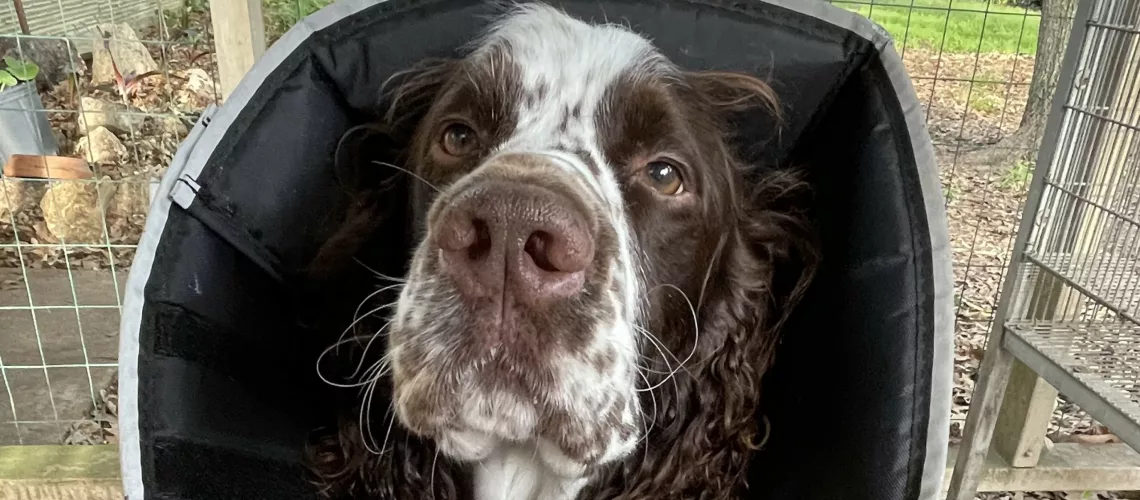Since it’s April Fool’s Day, let’s fool your dog by playing pretend games to prepare for real experiences! You never know when your dog will be asked to wear a cone to prevent licking a wound or surgery incision, or to allow a skin problem to heal. It’s only fair to help him learn to cooperate with this necessary treatment! Grab a clicker and a bunch of training treats and let’s get started.

Protocol for Teaching Your Dog to Wear a Cone on His Head
- It’s a game!
- Put the cone on the floor. CLICK* as your dog sniffs or moves toward it. Give him a treat immediately after you click.
- It’s his choice – he can move away at any time.
- Make it short and sweet: set out 10 treats; when they are gone, put the cone away.
I said “fool your dog” above, but I didn’t mean it literally! Just change his mind. Some people think that dogs have to “put up with” negative events in their lives. But when you learn about training, you understand that we can change dogs’ minds. We can teach them to enjoy things that are not naturally attractive to them through association, just like Pavlov did! This helps us take care of them in a better way, a way in which they are partners in their own care.
- DO NOT be in a hurry. Don’t try to “trick” your dog and get the cone on his head! Everyone knows we can make the dog wear the cone – the point is to condition him to WANT to wear the cone.
- Hold the cone in your hand and play the same game: CLICK for approach or stretching his nose toward it. Follow with a treat.
- 10 treats, 10 repetitions.
- Mix up cone positions: put the cone on the floor, hold it, lay it on a low step stool, place it on your lap, etc. This will help your dog understand that the cone itself produces the clicks and treats! The cone is the key, not the location or anything else.
How many repetitions will it take before you can move toward having him put his head in the cone? I suggest 10 sessions of 10 repetitions each before you consider increasing what you’re asking of your dog. You may need to adjust this. Your dog may already have a negative association with the cone, developed from a surgery or injury while he was with you, or even before he met you. Take your time and act like you don’t care how long it takes! That will take the pressure off your dog and you’ll achieve your goal in no time.
- Loosen the cone’s straps or ties; hold it up so your dog COULD put his head through, if he chose to. NO HURRY – it’s a teaching process.
- Present the cone just far enough in front of his face so that he CAN take a step toward it, but not so far that he has to take several steps to get to it.
- Click/treat/repeat. Positive reinforcement builds behavior: watch it work for you!
- If your dog holds his head still inside the cone, give him a few treats in a row! He’s doing it! No click needed because clicks are for action. But treats are the primary reinforcer, so keep them coming to let him know he’s making a good choice! After 6 or 8 treats, take the cone off. Great progress!
- It’s time to add in other types of reinforcement (rewards). Get your dog to put his head in the cone, give a treat or two, gently play with a toy, pet him in a way that he loves, or practice some easy behaviors that he’s really good at. Try getting him to sit, walk a few steps at your side, or give you a paw if he knows those behaviors. Of course, he gets a treat every time he does what you ask. The treats will be associated with the behaviors but also with the cone. You’re generalizing at this point – getting the dog to wear the cone under slightly different conditions.
- DO NOT leave the cone on long enough for him to get tired of it and scrape it off on his own; that defeats your purpose! You must always be the one to take off the cone. He needs time to learn to wear it for more extended periods of time. So keep up the training.
One of the “secrets” to good training is to commit to your goal. Gently “push the envelope” of success. Along the way, you’ll discover points of success – your dog will be really good at some specific part. That’s great, and he gets lots of treats for it; and it’s your new starting point for further training. Gently ask him for a little bit more. Never give up, never settle for “good enough”. Know that your goal is sound and you can reach it.
At the same time, don’t be afraid to slow down, to ask your dog for a little bit less, to practice the part that’s easy for him, a few extra times. Dogs and humans both have moments when it’s easier to learn, and those when it’s harder. Recognize a little difficulty when you see it. Help your dog move past it like a good teacher.
Of course your dog doesn’t naturally want to wear a cone – who would? It’s cumbersome, annoying, gets in the way of doing doggie things. But behavior science has shown us that we can change a dog’s mind about things like a cone. We can literally create a new situation in which he volunteers to put it on. You will have to continue developing this skill set. Do that by playing, walking, or taking him to a new place to sniff while the cone is on his head – he’ll start to wonder what fun is in store when the cone goes on!
Imagine what it will be like for your dog if he ever has to wear a cone for an actual, necessary medical reason! Not only will it not be another negative thing in the midst of a painful and scary event, but it will be a good and happy thing for him because you prepared him. He’ll heal faster because he won’t be stressed out by the cone.
April Fool’s! It’s not so bad to wear a cone!
Be the first to read our monthly training application blog posts, designed for you to use with your own pet right away! Subscribers also receive a monthly education and inspirational post about training and behavior, best enjoyed with a cup of coffee or the relaxing beverage of your choice. Sign up for our mailing list at the bottom of this page!


